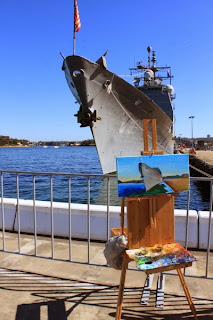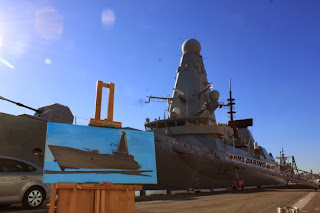 |
MP9 'Millers Point, Barangaroo and the Harbour Tower from High st' oil on canvas 61 x 183cm 2014 Enquiries |
At first sight, it looks peaceful. Charming enough to put on the cover of a chocolate box.
Does it remind you of the Impressionists perhaps? Pissaro, even early Monet?
To the right is a charming row of Federation houses in dappled shade.
But there are undercurrents. All is not well.
There is a sharp sudden drop to the street below.
Behind a camouflaging line of trees there is turmoil. Machinery lurks in the background; inexplicable concrete structures and mounds of debris peek through.
A road carves through the centre to the horizon.
It divides the past from the future.
Welcome to Barangaroo.
 |
| MP9 'Millers Point, Barangaroo and the Harbour Tower from High st' oil on canvas 61 x 183cm 2014 Enquiries |
Millers Point always had a raffish edge. It was a tough little quarter, the oldest suburb in Australia, and coincidentally its earliest slum. For over 200 years it was the heart of maritime Sydney, as ships loaded wheat, wool and coal at the Fingerwharves that fringed the Harbour from Woolloomooloo to Blackwattle Bay.
Now it is undergoing a painful and cataclysmic metamorphosis. Every vestige of its colourful past will be swept away.
 |
| MP9 'Millers Point, Barangaroo and the Harbour Tower from High st' oil on canvas 61 x 183cm 2014 Enquiries |
Including the people.
 |
| The artist painting MP9 'Millers Point, Barangaroo and the Harbour Tower from High st' oil on canvas 61 x 183cm 2014 Enquiries |
Social cleansing is not a new policy dating from our own era of economic rationalism. It’s been here before.
In January 1900, the bubonic plague first broke out in Sydney, carried by rats from the ships. Millers Point was popularly considered to be a festering slum, inhabited by social undesirables living in ignorance poverty and filth. This was all the excuse the government needed for a massive program of slum clearance that went well beyond simple health precautions.
In January 1900, the bubonic plague first broke out in Sydney, carried by rats from the ships. Millers Point was popularly considered to be a festering slum, inhabited by social undesirables living in ignorance poverty and filth. This was all the excuse the government needed for a massive program of slum clearance that went well beyond simple health precautions.
%2Bcrop.jpg) |
| Painting MP9 'Millers Point. Barangaroo and the Harbour Tower from High st' oil on canvas 61 x 183cm 2014 Enquiries |
This attitude permitted those with political or commercial interests at heart to promote resumption of property in the name of morality and hygiene. To “purge” the city of perceived social ills, whole city blocks were cordoned off, many houses and even whole streets were demolished.The entire waterfront was put in lockdown until it resembled a quarantined war-zone.
The idea of a “tabula rasa” – a clean sheet, a blank canvas, has always been very seductive to planners. Development through decay, dereliction then destruction is the familiar theme running through Sydney’s history.
Throughout the plague and clearances, yellow ribbons were tied to the doors of houses with infected people inside, or on the doors of houses due for demolition, to mark danger.
The idea of a “tabula rasa” – a clean sheet, a blank canvas, has always been very seductive to planners. Development through decay, dereliction then destruction is the familiar theme running through Sydney’s history.
Throughout the plague and clearances, yellow ribbons were tied to the doors of houses with infected people inside, or on the doors of houses due for demolition, to mark danger.
 |
| Painting MP9 'Millers Point, Barangaroo and the Harbour Tower from High st' oil on canvas 61 x 183cm 2014 Enquiries |
One hundred years later, the area was yet again in danger. It only escaped complete demolition due to the heated campaign by activists, residents and the Green Bans imposed by Jack Mundey and the NSW Builders' Labourers Federation.
As the maritime industry declined and was forced to the periphery of Sydney, the wharves were given a makeover to become upmarket apartments and an entertainment precinct. In 1985 ownership of public housing was removed from the Maritime Services Board and taken over by the Department of Housing. Yet a tiny enclave of the old working-class Sydney community still exists.
The phrase “spirit of place” is often overused, but how else can you describe it? People whose families had worked on the wharves, in some cases over 5 generations, are still clinging there precariously, in the houses they had lived in all their lives.
 |
| Sunset, Millers Point. MP9 'Millers Point Barangaroo and the Harbour Tower from High st' oil on canvas 61 x 183cm 2014 with another half finished panorama of the same size of High Street and Barangaroo on my easel. Enquiries |
There has been extraordinary pressure exerted to gentrify the area. A six-star hotel and high-rollers casino are planned for Barangaroo, only a stone’s throw away.
The first auctions of 293 public housing properties at Millers Point and The Rocks have begun. Ironically this will even include the Sirius apartment complex, which had been specifically built to house residents displaced during the previous development push.
There is no guarantee the proceeds will be quarantined from general revenue to build new public housing in the area or even close to the CBD.
Millers Point residents will have to go within two years, coincidentally when Barangaroo will open.
The first auctions of 293 public housing properties at Millers Point and The Rocks have begun. Ironically this will even include the Sirius apartment complex, which had been specifically built to house residents displaced during the previous development push.
There is no guarantee the proceeds will be quarantined from general revenue to build new public housing in the area or even close to the CBD.
Millers Point residents will have to go within two years, coincidentally when Barangaroo will open.
 |
| Close up detail of gate with yellow ribbon on house in High Street MP9 'Millers Point Barangaroo and the Harbour Tower from High st' oil on canvas 61 x 183cm 2014 Enquiries |
The yellow ribbons are back, tied to the doors and gates, to warn of an old danger in a new form.
Plus ça change, plus ça meme chose.
 |
| Painting MP9 'Millers Point, Barangaroo and the Harbour Tower from High st' oil on canvas 61 x 183cm 2014 Enquiries |
If you look carefully, their paintings are full of clues. Those elegant Parisian boulevardes painted by Caillebotte, are wounds inflicted on the city when small laneways were bulldozed, and the residents evicted.
Montmarte, too steep for easy access, escaped this homogenization, and was still full of crooked narrow lanes and cheap housing. Many fled there, including some impoverished artists who later became the world famous icons of Impressionist art.
Their paintings don’t look so “chocolate box” now, do they?
 |
Close up detail showing the partly obscured "Barangaroo" sign MP9 'Millers Point Barangaroo and the Harbour Tower from High st'
oil on canvas 61 x 183cm 2014 |
But the letters are partially obscured; all you can make out is “a n g ...r”.
Hidden anger? With a sugar coating.
Related articles


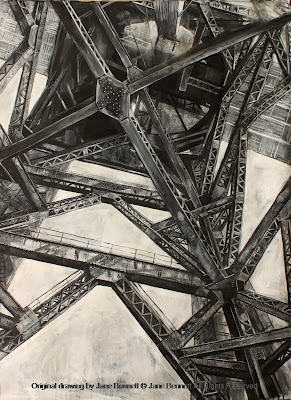



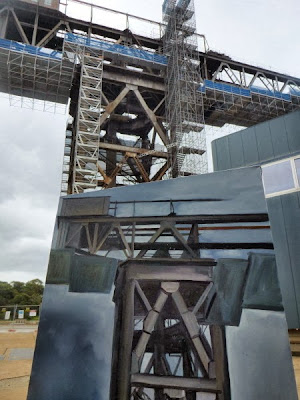
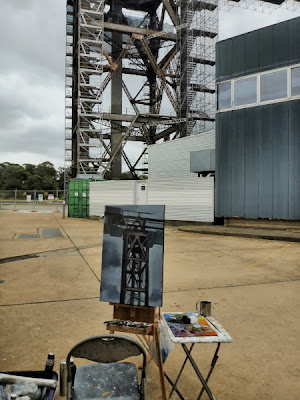
.jpg)
.jpg)






